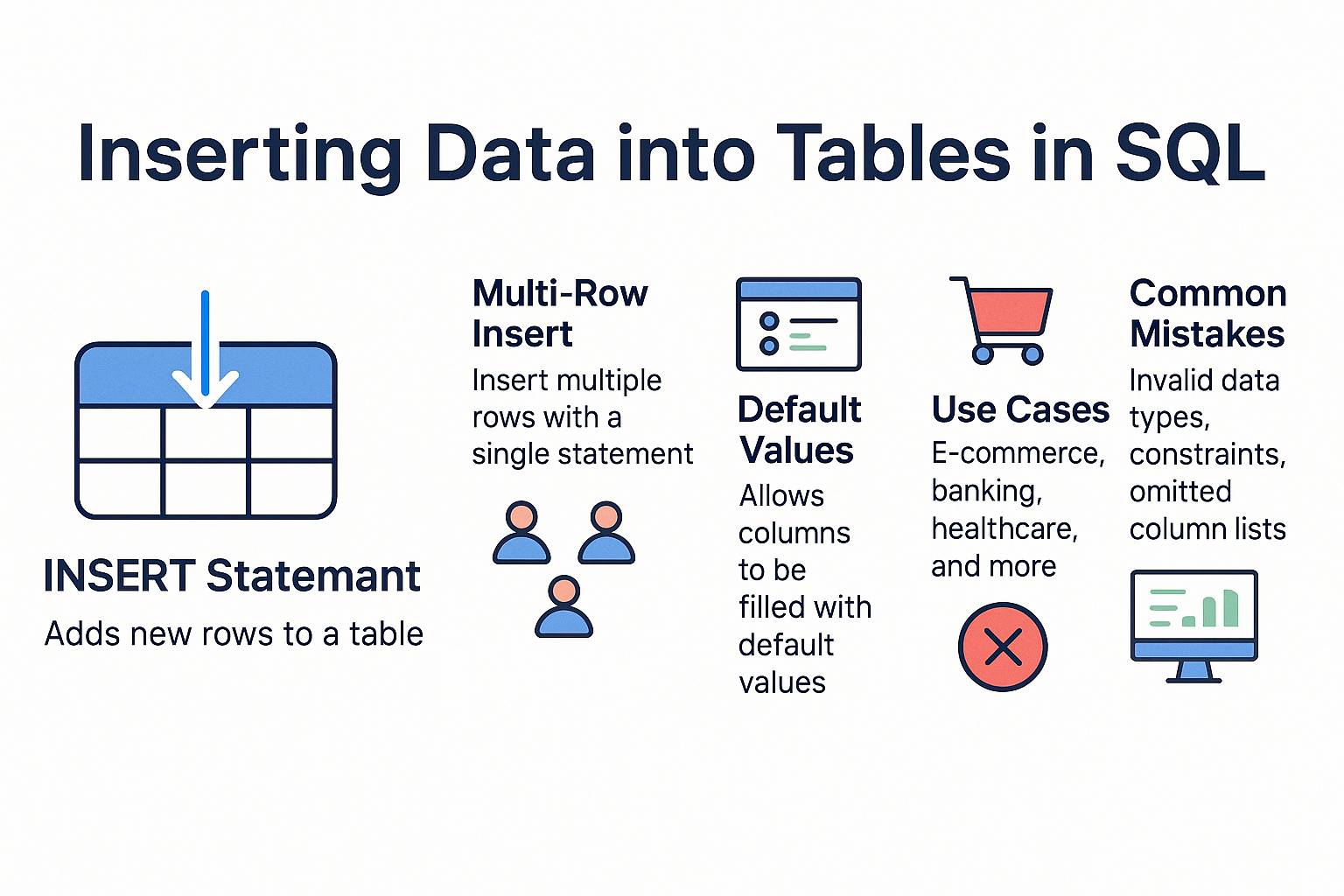Introduction
Inserting data is one of the most fundamental database operations. After creating tables, you need to populate them with meaningful data to power your applications.
Why It Matters
- Data storage: Populates tables for querying and analytics.
- Application functionality: Applications rely on inserted data to work properly.
- Testing environments: Sample data helps test queries and performance.
Real-world analogy:
Think of a table as an empty spreadsheet. Inserting data is like filling in rows with customer information, product details, or transactions.
Core Concepts
INSERT Statement
The INSERT statement adds new rows to a table.
Single Row Insert
INSERT INTO customers (name, email)
VALUES ('John Smith', 'john@example.com');
Multi-Row Insert
INSERT INTO customers (name, email)
VALUES
('Jane Doe', 'jane@example.com'),
('Mike Ross', 'mike@example.com');
Inserting with All Columns
INSERT INTO customers
VALUES (1, 'John Smith', 'john@example.com', '2025-07-31');
Inserting with Default Values
INSERT INTO customers (name, email)
VALUES ('Alice Brown', 'alice@example.com');
Real-World Use Cases
- E-commerce: Adding new customers and orders.
- Banking: Recording transactions.
- Healthcare: Storing patient registrations.
Common Mistakes and Anti-Patterns
- Omitting column list: Can break when table structure changes.
- Inserting invalid data types: Causes errors or silent truncation.
- Ignoring constraints: Violates unique or foreign key rules.
Performance and Scalability Implications
- Batch inserts are faster than individual single-row inserts.
- Prepared statements improve performance for repeated inserts.
- Large insert operations should be wrapped in transactions for consistency.
RDBMS Comparison
| Feature | PostgreSQL | MySQL | Oracle |
|---|---|---|---|
| Multi-Row Insert | Fully supported | Fully supported | Requires UNION ALL |
| Default Values | Supported | Supported | Supported |
| Returning Clause | Supported | Not supported | Supported |
Best Practices & Optimization Tips
- Always specify column names in
INSERTstatements. - Use transactions to ensure atomicity for bulk inserts.
- Validate data before insertion to avoid constraint violations.
- Use prepared statements for performance and security (SQL injection prevention).
When to Use vs When to Avoid
Use INSERT When:
- Adding new records to tables.
- Populating lookup tables with static data.
Avoid Excessive Inserts When:
- Using row-by-row inserts for large datasets; prefer bulk loading tools.
Conclusion & Key Takeaways
Inserting data is at the core of database operations. Using correct syntax, best practices, and optimization strategies ensures data integrity and performance.
Key Points:
- Use
INSERTwith explicit column names. - Batch inserts for better performance.
- Validate and secure data before insertion.
FAQ
1. What is the basic syntax for inserting data?INSERT INTO table_name (columns) VALUES (values);
2. Can I insert multiple rows at once?
Yes, using multi-row inserts or bulk loading.
3. What happens if I omit column names?
Values must match all table columns in order; not recommended.
4. Can I insert data into a view?
Yes, if the view is updatable.
5. What is the RETURNING clause in PostgreSQL?
It returns inserted values without a separate SELECT query.
6. How do I handle duplicate inserts?
Use ON CONFLICT (PostgreSQL) or INSERT IGNORE (MySQL).
7. Can I insert NULL values?
Yes, unless the column is defined as NOT NULL.
8. How to speed up large inserts?
Use transactions, batch inserts, or database-specific bulk loaders.
9. Can I insert into multiple tables at once?
Not directly; use triggers or stored procedures.
10. What’s the difference between INSERT and COPY/LOAD?INSERT is standard SQL; COPY/LOAD are faster bulk import commands.
